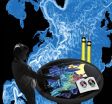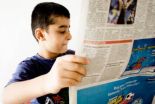(Press-News.org) Strasbourg, France, 10 December, 2012: Dedicated funding and support is required to ensure personalised medicine can be implemented across Europe's healthcare systems, according to a new report issued by the European Science Foundation's (ESF) membership organisation for all medical research councils in Europe, the European Medical Research Councils (EMRC).
The report entitled Personalised Medicine for the European Citizen, brought together experts from a wide range of disciplines to identify the most pressing issues affecting the development and implementation of personalised medicine across Europe. Key stakeholders, from patient groups to regulators to industry and academia were consulted through a series of meetings designed to facilitate the discussion on the key issues.
Personalised medicine, a strategy based on individual phenotyping of profiles rather than the long established 'one-size-fits-all' approach identifies elements that predict the individuals' response to treatment and their predisposition to disease. This healthcare model places heavy emphasis on the maintenance and investment of these cohorts providing a healthcare system with a modern, prospective approach; an essential strategy for the analysis and understanding of disease over time in well characterised populations.
Professor Stephen Holgate, Clinical Professor of Immunopharmacology at the University of Southampton and a leading expert in the consultation commented: "Personalised medicine has become increasingly important in the future of healthcare. By targeting patients with specific treatment programmes tailored to the individuals needs."
Alongside Professor Holgate, the science committee responsible for compiling this report included: Professor Aarno Palotie, Institute for Molecular Medicine Finland, University of Helsinki, Finland; Professor Barbara Prainsack, Centre for Biomedicine & Society, Brunel University, United Kingdom; Professor Angela Brand, Institute for Public Health Genomics, Maastricht University, The Netherlands; and Professor Hans Lehrach, Max Planck Institute for Molecular Genetics, Germany.
The report outlined a series of recommendations under four core headings:
1. Data handling
Comprehensive, accessible and interoperable datasets must be generated to support the development of a new disease taxonomy and allow for its ongoing refinement and application.
2. Models and decision-making processes
Models and decision-making processes must be revised to reflect a focus on the individual. This should happen at all levels, from assessment of the safety and efficacy of interventions, through HTA and reimbursement, to diagnosis, treatment and prevention.
3. Interdisciplinarity, participation and translational research
Emphasis must be placed on stakeholder participation, interdisciplinary interaction, public-private and precompetitive partnerships, and translational research in order to develop the frameworks that support the vision of personalised medicine and healthcare.
4. Infrastructure and resources
Dedicated funding and governmental support must be provided to ensure the availability of core infrastructure, including access to core technology and frameworks for education and training of professionals and the wider community.
###
Professor Liselotte Højgaard, the Chair of the European Medical Research l Councils (EMRC): "We hope that the recommendations in our report will now be taken up by stakeholders throughout Europe to ensure the successful introduction and sustainable implementation of personalised medicine."
These recommendations are outlined in the newly published Forward Look entitled: Personalised Medicine for the European Citizen. To view the full report, please click here.
Notes to Editors
For a copy of the report, to request interviews or more information please contact:
Emma Knott
Tel +44(0)20 3176 4715
Email emma.knott@kaizo.net
The European Science Foundation (ESF) is an independent, non-governmental organisation that promotes cross-border collaboration in scientific research, research funding and science policy across Europe. The European Medical Research Councils (EMRC) was the membership organisation under the ESF of 37 medical research councils in 30 European countries. Its mission has been to promote innovative medical research and its clinical application towards improved human health. www.esf.org
Leading experts urge Europe to implement personalized medicine in healthcare
2012-12-10
ELSE PRESS RELEASES FROM THIS DATE:
Prospectus addresses most pressing marine science questions
2012-12-10
The most pressing issues that UK marine science needs to address over the next two decades are the subject of a prospectus published as a themed issue of the Philosophical Transactions of the Royal Society A last month. The volume is co-edited and carries contributions by scientists based at the National Oceanography Centre Southampton (NOCS).
Human-induced changes in ocean processes are already being observed, and are projected to intensify as demand for the ocean's resources continues to increase. The prospectus, introduced as `A strategy for UK marine science for ...
Just 28 percent of young people in Spain read either online or conventional newspapers each day
2012-12-10
A study at the Jaume I University in Castellón has verified the decrease in press consumption among young people between the ages of 16 and 30 years, which now stands at 28.8%. What is more, three out of every four individuals within this age bracket use social networking sites more than the television to get up to date.
News consumption habits among young people have changed radically in recent years. Since the beginning of the 21st century, various studies have indicated a decrease in readership of printed newspapers along with a constant fall in young readers.
"Just ...
Iron supplements reduce ADHD in low birth weight infants
2012-12-10
In a study published today in Pediatrics, scientists at Umeå University in Sweden conclude that giving iron supplements to low birth weight infants reduces the risk of behavior problems like ADHD later in life.
The study, Effects of Iron Supplementation on LBW Infants on Cognition and Behavior at 3 Years, is published in the January 2013 issue, released online Dec. 10, 2012.
In the randomized controlled trial, researchers in Sweden gave 285 marginally low birth weight infants either 0, 1 or 2 mg/kg and day of iron supplements from 6 weeks to 6 months of age. At age ...
Palliative care improves outcomes for seniors
2012-12-10
Seniors in long-term care experienced a significant reduction in emergency room visits and depression when receiving palliative care services, according to a recent collaborative study by researchers at Hebrew SeniorLife's Hebrew Rehabilitation Center (HRC) and Institute for Aging Research, both affiliated with Harvard Medical School (HMS).
The results of the study, published today in The Gerontologist, demonstrate the potential for improved end-of-life quality of care when palliative services are implemented in a long-term care setting.
The researchers analyzed the ...
Tracking gene flow in marine plant evolution
2012-12-10
A new method that could give a deeper insight into evolutional biology by tracing directionality in gene migration has just appeared in EPJ Data Science. Paolo Masucci from the Centre for Advanced Spatial Analysis, at University College of London, UK, and colleagues identified the segregation of genes that a marine plant underwent during its evolution. They found that the exchange of genes, or gene flow, between populations of a marine plant went westward from the Mediterranean to the Atlantic. This methodology could also be used to estimate the information flow in complex ...
Carbon nanotubes lower nerve-damaging chloride in cells
2012-12-10
DURHAM, N.C. -- A nanomaterial engineered by researchers at Duke can help regulate chloride levels in nerve cells that contribute to chronic pain, epilepsy, and traumatic brain injury.
The findings, published online Dec. 10, 2012, in the journal Small, were demonstrated in individual nerve cells as well as in the brains of mice and rats, and may have future applications in intracranial or spinal devices to help treat neural injuries.
Carbon nanotubes are a nanomaterial with unique features, including mechanical strength and electrical conductivity. These characteristics, ...
Tiny compound semiconductor transistor could challenge silicon's dominance
2012-12-10
CAMBRIDGE, Mass. -- Silicon's crown is under threat: The semiconductor's days as the king of microchips for computers and smart devices could be numbered, thanks to the development of the smallest transistor ever to be built from a rival material, indium gallium arsenide.
The compound transistor, built by a team in MIT's Microsystems Technology Laboratories, performs well despite being just 22 nanometers (billionths of a meter) in length. This makes it a promising candidate to eventually replace silicon in computing devices, says co-developer Jesús del Alamo, the Donner ...
Study of text messaging service shows participants prepared for motherhood
2012-12-10
Contact: Rachel Griffith
rgriffith@hmhb.org
703-797-1945
Contact: Kathy Fackelmann
kfackelmann@gwu.edu
202-994-8354
George Washington University
Study of text messaging service shows participants prepared for motherhood
Following last week's mHealth Summit, the largest event of its kind where leaders focus on how wireless technology can improve health outcomes, text4baby announced results from the first randomized evaluation of its service. The largest mobile health initiative in the U.S., text4baby was found to be an effective service for pregnant women.
...
'Public ecology' could help resolve mountaintop mining issues
2012-12-10
Mountaintop mining is the practice of using huge machines to remove layers of soil and rock to reach thin seams of coal.
It is an efficient way to reach the high-thermal value, low-impurity coal in the central Appalachian range, which accounts for one-fifth of the nation's coal, and it is a resource for American energy independence.
But it has disadvantages — mountaintops are deposited into valleys, trees and habitats are destroyed, chemical drainage may pollute streams, and many find it ugly.
Taking conflicts into account — such as the benefits of steady jobs and ...
Stem cell research provides hope for infertile cancer survivors
2012-12-10
Radiation and chemotherapy can pack a powerful punch against all kinds of cancers. Those who survive, however, are often left with bad news: Their treatments have rendered them infertile.
A UTSA professor has now demonstrated that it is possible to remove testicular stem cells from a monkey prior to chemotherapy, freeze them and later, after cancer treatments, transplant these cells where they can restart sperm production and restore fertility.
UTSA Assistant Professor Brian Hermann worked in collaboration with researchers at the University of Pittsburgh School of Medicine's ...

